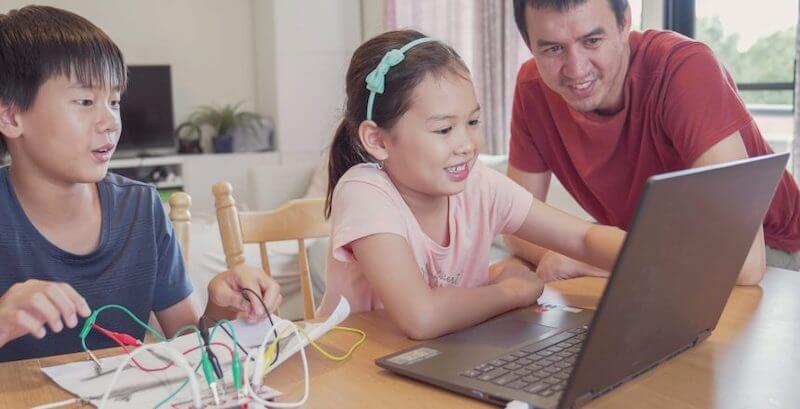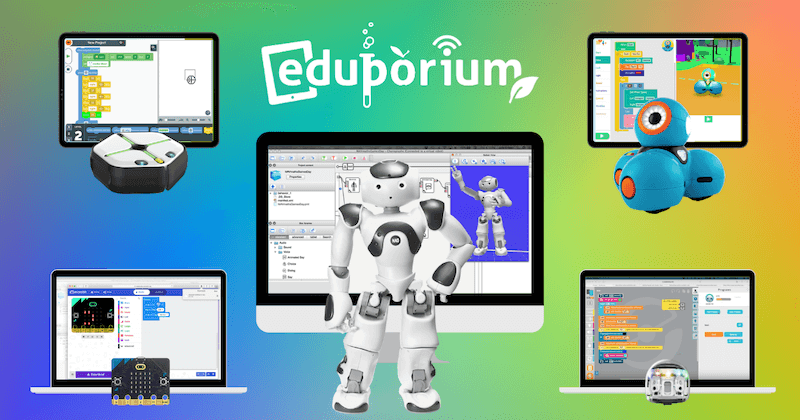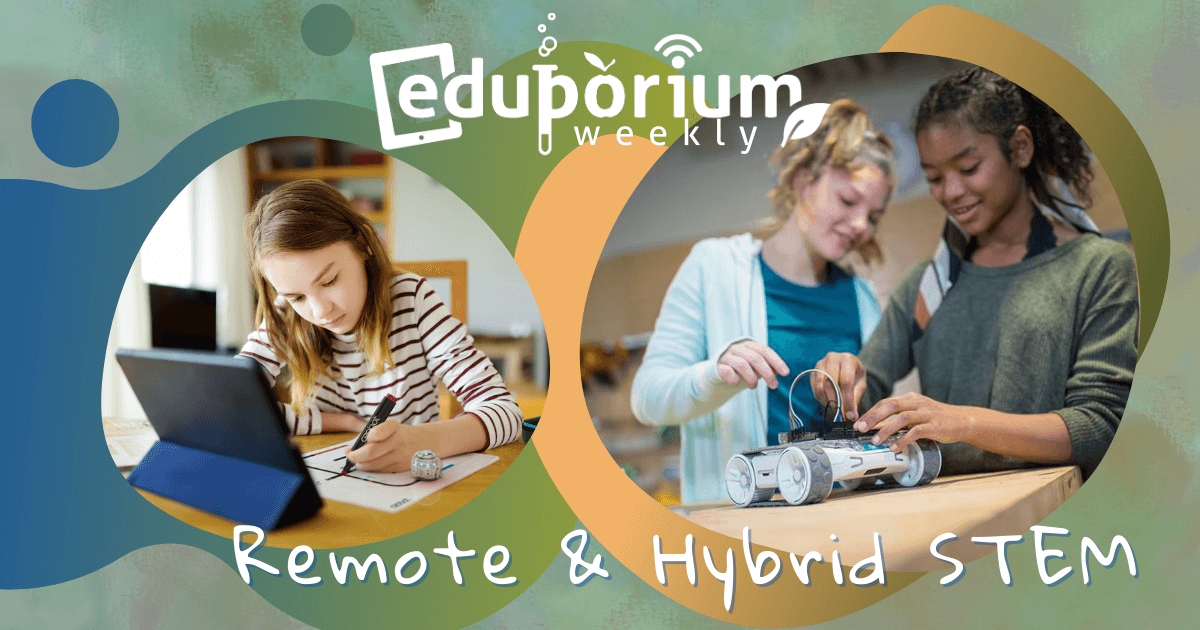In an ideal world, there would be no limitations when it comes to facilitating hands-on learning for remote students. Ideally, learning wouldn’t need to take place remotely at all, but it is and it’s no secret that’s led to fewer real-world experiences for students. While not impossible, planning for remote learning and STEM presents obstacles for educators. These include finding the time to fit it into shorter meetings, creating lesson plans, and getting technology materials to students. Online STEM platforms have provided one solution for many students and they're great when accessible. Replicating that hands-on experience from the classroom, however, can be tricky, so, we’re sharing some insights on how to start.
Boosting Engagement in Remote STEM Learning
Replicating STEM activities and experiences in a virtual meeting can, of course, be challenging. Forced to find a way, however, many educators have outlined some creative approaches. One of the first things educators should do when looking to integrate more hands-on STEM lessons in remote or hybrid learning is one of the first things they probably did when beginning distance learning way back when: Communicate expectations to students and help them develop a personal method for meeting those expectations. Outlining class policies from the start will help eliminate wasted time and could assist in bumping up the efficiency with which students complete activities. In other words, if they have a physical EdTech tool, they should have it charged and ready for the project.
The experience is in the design.
In designing active experiences, educators should look to leverage tech tools that promote design thinking, problem solving, and critical thinking. One solution for this is to simply take project-based learning virtual and allow students to collaborate on authentic projects—just in a different way. Using video chat platforms would be key in this situation. They'd help get students to incorporate design thinking and problem solving that's key for developing STEM skills in school. Another strategy is to try the flipped classroom in remote learning. This would involve educators providing video instruction for students before meetings, allowing them to work on projects while meeting synchronously. This creates the opportunity for asking questions, working through problems, and more effective academic experiences.
Student support in remote STEM.
Offering students support is another key component to ensuring remote STEM learning is effective. Building a support system for students by identifying challenges and pain points can help educators provide the right kinds of feedback and suggestions for helping get things back on track. If possible, students can work in smaller groups and collaborate on possible solutions for any struggles. Working in smaller groups also allows students to get to know each other better and will likely help enhance the collaborative nature of STEAM learning even though they’re not physically together. Having the experience of working together to solve problems virtually can really come in handy in the future.

Juggling STEM Learning Remotely
In order to be effective, STEM experiences have to engage students from start to finish. That should come as no surprise given the previous section of this post was dedicated to the topic of engaging students in STEM that’s part of remote learning. Getting students engaged in any lesson, really, through the screen of a computer has proven to be challenging. STEM lessons, in particular, present additional roadblocks. If possible to get STEM materials to students, one strategy could be projecting meetings on a screen whether they’re in the classroom or at home. Of course, this necessitates new tools, but being able to more easily see students working through an activity is a worthwhile cause. This strategy would also work in a hybrid setting, allowing educators to observe students at home more easily.
Digital tools replicate concepts.
Another way educators can bring better STEM experiences to remote learning is to research and inquire about online educational platforms. As you know by now, there are thousands of them and they’re all used for different things. If in a physics class, for example, teachers can try looking for a tool that replicates and displays concepts more clearly for students. The same goes for any of the sciences and leveraging social media can help teachers learn about additional tools for their subjects. Also, if students are completing a STEM activity remotely, it could be natural for them to simply go about their business and complete the project. In order to better engage them, however, it’s often up to the teacher to observe them. They also should question their approaches and get them thinking about alternatives or why something worked how it did.
Realistic expectations for STEM outcomes.
It’s important for teachers to be cognizant of what students are doing in independent STEM learning. They should also be okay with letting go of some of that structure. As we know, this is a strange time and every student is processing things differently, leaving many of them going about learning in their own unique way. It's good for teachers to adjust expectations and limit frustration if students have an unexpected way of attempting STEM assignments. Thinking about remote STEM learning as a marathon rather than a sprint is also important. Building positive experiences can help students (and teachers) gather momentum that could continue through the duration of remote learning. And, finally, working with a team of other educators can help a lot—in terms of lesson planning, student observation, and staying emotionally balanced.
Tips for Teaching STEM Remotely
Thinking of STEM, one of its greatest benefits is how its hands-on nature gets students more active and engaged. This has proven to be tougher in remote learning unless students can use hands-on STEM materials at home. This could also work if they're in the classroom on a regular basis as part of their hybrid learning schedule. If unable to make remote STEM fully hands-on, teachers can at least make it more interactive with student involvement. One of the best ways to build student excitement involves teachers using their own attitudes and actions to drive discussions. Teachers could do this by asking quick, open-ended questions to different students throughout lessons. Or, they could set up a system in which students submit questions or thoughts on the fly.
Consider starting group discussions.
Another strategy for teachers is to find and take advantage of short videos to fill in some of the gaps throughout lessons. This can help make them more engaging for students and keep their attention more effectively. Encouraging them to note their questions as they watch can provide everyone in the class with interesting discussion topics whether that’s immediately or the next day. This could be especially helpful if they’re working with STEM or maker technologies remotely. Oftentimes, these tools require assembly and there could be more than one way to do that correctly. Encouraging students to share their thoughts throughout the process in a quick, bullet-point style could lead to some good discussions. Asking them what it is they want to get out of certain lessons could also help educators steer them in a certain direction.
Remote Learning STEM Considerations
In designing remote lessons, educators should try to create lessons that students can complete in the classroom or at home. Oftentimes, big-picture goals can be achieved regardless of student location and instructional models. It can also be helpful to consider any potential limitations to the lesson if it's facilitated remotely. In terms of STEM experiences, students would likely need physical space, reliable technology, and freedom to experiment. It can be good to think about how projects would mesh in the classroom as well as in the event of a transition to hybrid or in-person learning. Finally, getting students to collaborate will make STEM lessons more rewarding. If they’re in the classroom together, this is an opportunity that should be taken advantage of. If always remote, setting aside time for some breakout group work is a decent alternative.

Getting to a Place to Better Teach STEM Remotely
Like anything, learning what works in delivering online STEM education is a process that is going to take time. Even if relying on a trial-and-error approach, takeaways aren’t going to present themselves in a data-driven form right away. If educators are relying on their natural abilities and previously used instructional methods as they try to effectively teach hands-on subjects to students remotely, it might not be going as well as they might have hoped so far. Unfortunately, the tried and true remedy for this predicament is to provide teachers with more professional learning. While PD opportunities are great and many teachers truly enjoy them, this isn’t exactly an ideal time, however. Giving them new things to learn and adding more responsibilities onto their already overflowing plates isn't great.
Is it worth requiring PD?
PD could help, but teachers must be able to determine if the hands-on tools are supporting learning and development. Being able to closely watch how students use them in their problem-solving processes could give educators an idea of how effective certain tech tools are in helping them build relevant competencies. To be completely honest, replicating the engagement levels of a STEM classroom is not something that’s likely to happen. Especially in remote learning and, it would also likely be expensive. It would probably require high tech equipment, like cameras and microphones, so that students could collaborate, see what their partners are doing, and share ideas in real-time. In an ideal world, educators would probably love this, but it's tough to get something like that off the ground.
IT staff members could help.
It depends on the ages and ability levels of students, but, in remote learning, it’s important they know how to use all technology platforms involved. This means educators would need to be able to show them how—coming back to the topic of increased remote PD. With help from school IT professionals, hopefully the learning curve can be thinned. Just remember that the ultimate goal of using this technology is to provide students with fruitful experiences. Creating a unified technology plan and modeling it schoolwide can be one effective strategy and finding a way to make it viable for educators trying to use different STEM tools in remote learning is a bonus. Networks will have to be strong, video meetings will have to occur, and support will probably need to be available. It definitely sounds daunting, but STEM experiences are much too important for today’s students to simply give up.
Making the Most out of STEM at Home
When it comes to distance learning STEM experiences, they don’t all have to be academic. Students can still learn a lot by simply using their natural inquiry to explore a new topic or setting right from home. Outdoor education can yield meaningful STEM connections and it’s often an easy way to get kids thinking about new ideas. More on the academic side of things, educators can use a similar strategy to design meaningful STEM learning for students, too. Despite physical distance, students can still connect with members of the community or STEM professionals using tools like Skype or Zoom. STEM jobs are extremely important in the pandemic era, providing a topic for discussion. If teachers are able to book a professional who’s been trying to battle it in an innovative way, that would make a great STEM lesson.
Capitalizing on student curiosity.
Students naturally have a lot of questions about things—especially things that might be happening as a result of the pandemic. Using this curiosity to drive some real-world research is a great example of STEM learning at home. This could also create opportunities for student collaboration. Working in groups could fill one of the biggest voids created by the pandemic: A lack of communication and teamwork. Researching something of interest can help students design hypotheses, discover new facts, and learn new ways of problem solving. Students can also learn a lot when it comes to designing experiments and translating data. If they can’t enjoy the same STEM experiences as before, this is one of the next most favorable approaches.
New paths toward success.
While it’s not ideal to halt hands-on learning experiences, approaching STEM from another angle does have some of its own benefits. Hands-on opportunities will come again but, in the meantime, students can develop other key 21st century skills. At the top of the list is adaptation. Obviously, a ton of adapting has been going on for almost a year now. Figuring out new avenues to success in a far-from-optimal learning environment could go a long way in preparing students for the future. Students can also show what they learn in different ways, including presentations or multimedia projects. This provides an alternative form of assessment and one that’s more engaging and enjoyable for them. Just because students aren’t in the same place, group projects in distance learning aren't completely off the table.
For the latest EdTech, STEM, and 21st century education news, follow us on Twitter and Instagram. Like us on Facebook, too, or sign up for our newsletter for our latest product announcements and offerings. If you have an idea for an Eduporium Weekly theme, send us a message on social media or comment below.



